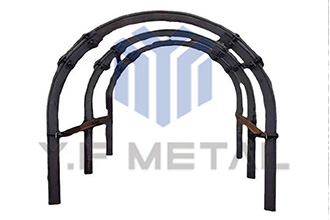U-Shaped Steel Arch Beam: The Backbone of Stable Underground & Tunnel Construction
If you’ve ever walked through a mine tunnel, driven through a mountain highway tunnel, or even visited an underground metro construction site, you’ve probably seen the quiet hero holding everything together: the U-shaped steel arch beam. It’s that curved, U-shaped steel structure spanning the top and sides of the tunnel, keeping loose rock, soil, and debris from caving in. I’ve spent 15 years working on underground projects—from small mine shafts to 6-lane highway tunnels—and I can say without hesitation: when the ground gets unstable, this beam is the difference between a safe job site and a disaster.
But here’s the thing most people don’t realize: U-shaped steel arch beams aren’t one-size-fits-all. Pick the wrong thickness, curve, or installation method, and you’ll end up with a beam that bends under pressure, leaving the tunnel vulnerable. I once saw a crew use a lightweight U-beam for a shale tunnel in Colorado; within a month, the beam had bowed inward, forcing us to shut down and replace all 20 sections. Don’t make that mistake. This guide will break down everything you need to know: what U-shaped steel arch beams are, why they’re irreplaceable in underground work, how to choose the right one, and how to install it so it holds strong—no fancy engineering jargon, just lessons from someone who’s been there.
What Is a U-Shaped Steel Arch Beam, and Why Does It Matter?
Let’s start simple: a U-shaped steel arch beam (often called a “U-steel arch” or just “U-beam” on site) is a hot-rolled steel structure bent into a U-shape, designed to form an arch over tunnel openings. Unlike flat steel plates or straight beams, its curved, U-like cross-section gives it two big advantages: first, it distributes weight evenly across the tunnel’s walls and floor (we call this “load distribution”); second, it resists bending and buckling under pressure—critical when you’re holding back tons of rock.

I remember my first time working with U-beams: I was 22, on a coal mine tunnel job in West Virginia. The foreman, Mike, pointed to a stack of rust-colored U-beams and said, “These are your best friends down here. The rock above us weighs 100 pounds per square foot—this beam’s gonna hold it back.” At the time, I thought he was exaggerating—until we removed a temporary wooden support and the rock started to creak. The U-beam didn’t even budge. That day, I learned why these beams are non-negotiable for underground work:
- They Handle Uneven Pressure: Tunnels rarely have uniform rock—some sections are soft shale, others are hard granite. A U-beam’s arch shape spreads pressure from loose or shifting rock across its entire structure, so no single spot takes too much weight. I saw this in action on a highway tunnel job in Utah: a section of soft soil pushed against the beam, but the arch distributed the pressure, and the beam stayed straight.
- They’re Flexible (But Not Too Flexible): Unlike rigid concrete arches, U-shaped steel beams have a little “give”—they can bend slightly without breaking if the ground shifts (like during a small seismic tremor). I worked on a tunnel in California near a fault line; a minor quake hit, and the U-beams flexed just enough to absorb the shock. Concrete arches would’ve cracked, but the U-beams held.
- They’re Easy to Assemble (Even in Tight Spaces): Most U-beams come in sections (usually 4–6 feet long) that bolt together. This is a lifesaver in narrow tunnels where you can’t fit big, one-piece structures. On a metro tunnel job in Chicago, we had only 8 feet of clearance—we bolted U-beam sections together one by one, and it worked perfectly.
When to Use U-Shaped Steel Arch Beams (And When to Skip Them)
U-beams aren’t for every job—they’re designed for specific underground conditions where stability is non-negotiable. Here are the scenarios where I always reach for them, and a few where they’re overkill:
1. Mine Tunnels (Coal, Metal, Mineral)
Mines are the most common place for U-beams—and for good reason. Mine tunnels are often dug through soft, fractured rock that’s prone to caving. A U-beam’s arch shape holds the roof up while leaving space for miners and equipment to move. I used 200 U-beams on a coal mine job in Pennsylvania last year; the tunnel was 10 feet wide, and we installed a beam every 5 feet. Not once did we have a roof collapse scare—something that’s all too common with cheaper wooden supports.
Pro tip: For mines with high moisture (like underground coal mines), use galvanized U-beams. Regular steel rusts fast in damp air, but galvanized steel resists rust for years. I once used uncoated U-beams in a wet mine—they started rusting in 6 months, and we had to replace them. Cost the client an extra $15,000.
2. Highway & Railway Tunnels
Highway and railway tunnels need U-beams that can handle heavy loads—both from the rock above and the constant vibration from cars or trains. I worked on a 4-lane highway tunnel in Colorado where we used 1-inch-thick U-beams with a 15-foot arch span. The beams had to support the weight of 10 feet of rock plus the vibration from 18-wheelers. Two years later, the tunnel’s still solid—no cracks, no bowing.
Skip this if: The tunnel is dug through solid granite with no fractures. Granite is hard and stable, so you might get away with lighter supports (like sprayed concrete). I did a small railway tunnel through granite in Montana—we used sprayed concrete instead of U-beams, and it’s still holding strong. No need to waste money on U-beams if you don’t need them.
3. Underground Metro & Subway Tunnels
Metro tunnels are narrow, deep, and often dug through urban soil (which is a mix of dirt, sand, and old building debris). U-beams are perfect here because they’re easy to install in tight spaces and can handle the uneven pressure from loose soil. I installed U-beams on a subway extension in Boston two years ago; the tunnel was only 12 feet wide, and we had to work around existing water pipes and electrical lines. The U-beam sections were small enough to maneuver, and we bolted them together without disrupting the city above.
4. Temporary Tunnel Supports (During Construction)
Even if a tunnel will eventually have permanent concrete supports, U-beams are great for temporary stability during excavation. I used U-beams as temporary supports on a water tunnel job in Washington state; we dug 50 feet of tunnel, installed a U-beam, then dug another 50 feet. Once the entire tunnel was dug, we added the permanent concrete lining over the U-beams. This kept the tunnel safe during construction—no collapses, no delays.
How to Choose the Right U-Shaped Steel Arch Beam (Avoid Costly Mistakes)
Picking the wrong U-beam is worse than not using one at all. Here’s what I always check before buying—lessons from years of messing up and fixing it:
1. Thickness (Gauge) Matters—Don’t Go Too Thin
U-beams come in thicknesses from 0.5 inches to 2 inches. The thicker the beam, the more weight it can handle. For soft rock or soil (like shale or sand), use 1–1.5-inch-thick beams. For hard rock (like granite) with minor fractures, 0.75–1-inch works. I once made the mistake of using 0.5-inch beams for a shale tunnel—they bowed in a week. We had to replace them with 1.25-inch beams, which cost the client an extra $8,000.
Rule of thumb: Calculate the “overburden pressure” (the weight of the rock/soil above the tunnel) before choosing thickness. A geologist can help with this—most construction companies have one on call. For example, if the overburden pressure is 150 pounds per square foot, you need at least a 1-inch-thick beam.
2. Arch Span (Width) Must Match the Tunnel
The arch span is the distance between the two ends of the U-beam (i.e., the width of the tunnel). U-beams come in spans from 6 feet (small mine shafts) to 30 feet (highway tunnels). Never force a beam with a smaller span than the tunnel—you’ll have to bend it, which weakens the steel. I saw a crew in Arizona try to bend a 10-foot span beam to fit a 12-foot tunnel; the beam cracked when they installed it.
Pro tip: Measure the tunnel width twice before ordering. Tunnels aren’t always perfectly straight—some have slight curves. For curved tunnels, order “segmented U-beams” (beams with small, curved sections) that fit the tunnel’s shape. I used segmented beams on a curved highway tunnel in Oregon—they fit like a glove, and the tunnel’s still stable.
3. Material: Carbon Steel vs. Galvanized Steel
Most U-beams are made from carbon steel (strong, cheap) or galvanized steel (resists rust). Use carbon steel for dry tunnels (like mine shafts in arid areas). Use galvanized steel for wet tunnels (like subway tunnels or mines with underground water). I used galvanized beams in a wet mine in West Virginia—they’re still rust-free after 5 years. Carbon steel would’ve rusted in 18 months.
If you’re on a budget: You can paint carbon steel with anti-rust paint instead of buying galvanized. It’s not as durable as galvanized, but it’s cheaper. I did this for a dry tunnel in Nevada—painted carbon steel beams are still holding up after 3 years.
4. Connection Type: Bolted vs. Welded
U-beam sections connect with either bolts or welds. Bolted connections are easier to install (no welding equipment needed) and can be adjusted if the beam shifts. Welded connections are stronger but take longer to install and can’t be adjusted. I prefer bolted connections for most jobs—they’re faster, and we can tighten the bolts if the beam loosens. On a mine job in Utah, we used bolted beams and had to adjust a few after a small rock shift—something we couldn’t have done with welded beams.
Skip welded connections if: You’re working in a narrow tunnel with no space for a welding machine. Bolted beams only need a wrench—perfect for tight spots.
How to Install U-Shaped Steel Arch Beams the Right Way (Step-by-Step)
Even the best U-beam fails if you install it wrong. Here’s my step-by-step guide, based on 15 years of installing beams in every condition:
Step 1: Prep the Tunnel (No Loose Rock!)
Before installing the beam, clear the tunnel of loose rock, dirt, or debris. Use a “scaling bar” (a long metal bar) to knock down loose rock from the roof and walls. I once skipped this step on a mine job—loose rock fell on the beam when we installed it, bending the top. We had to replace the beam and clear the rock, wasting a day.
Pro tip: Wear a hard hat and safety harness when scaling the tunnel. Loose rock can weigh 50+ pounds—you don’t want it falling on you.
Step 2: Install “Foot Plates” (Keep the Beam from Sinking)
Foot plates are flat steel plates that go under the ends of the U-beam (where the beam touches the tunnel floor). They spread the beam’s weight across the floor, so the beam doesn’t sink into soft soil. I always use 12×12-inch foot plates for U-beams—they’re big enough to prevent sinking. On a soft soil tunnel in Illinois, we forgot foot plates; the beam ends sank 2 inches in a week, and we had to lift the beam to add them.
Step 3: Assemble the Beam Sections (Bolt Tight, Don’t Over-Tighten)
If you’re using bolted U-beam sections, line up the sections and insert the bolts. Tighten the bolts with a torque wrench—most bolts need 80–100 N·m of torque (enough to be tight, but not so much that you strip the threads). I once over-tightened bolts on a beam in Colorado; the threads stripped, and we had to replace the bolts.
Pro tip: Use lock washers on the bolts. They keep the bolts from loosening if the tunnel shifts. I forgot lock washers on a mine job—half the bolts loosened in a month, and we had to retighten them.
Step 4: Secure the Beam to the Tunnel Walls (Add “Anchor Bolts”)
Once the beam is in place, drill anchor bolts through the beam and into the tunnel walls. This keeps the beam from moving sideways if the rock shifts. Install one anchor bolt every 2 feet along the beam—more if the rock is soft. I used 4 anchor bolts per beam on a soft shale tunnel in Pennsylvania; the beam hasn’t moved an inch.
Skip anchor bolts only if: The tunnel walls are made of solid granite with no fractures. Granite is strong enough to hold the beam without anchors. I did this for a granite tunnel in Montana—no anchor bolts, and the beam’s still stable.
Step 5: Check the Beam for Bowing (Do This Every Week!)
After installation, check the beam every week for bowing or loosening. Use a level to see if the beam is straight—if it’s bowed more than 1 inch, you need to add extra supports (like steel struts between beams). I caught a bowed beam in a Utah tunnel after 2 weeks; we added a strut, and the beam straightened out. If we’d waited, it would’ve cracked.
Real-World Example: U-Beams Saving a Highway Tunnel Job
Let me tell you about a job where U-beams made all the difference. Two years ago, I was hired to fix a highway tunnel in Colorado that was having roof collapse scares. The crew had used wooden supports, which were bending under the rock weight. We removed the wooden supports and installed 1.25-inch-thick galvanized U-beams with a 20-foot span. We used bolted connections and 4 anchor bolts per beam.
Three months later, a minor rock slide hit the tunnel. The U-beams flexed slightly but didn’t break—they held the rock back, and no one was hurt. The DOT inspector said the U-beams “saved the project.” If we’d used wooden supports or thinner steel, the tunnel would’ve collapsed, costing millions in repairs and shutting down the highway for months.
This is why I trust U-shaped steel arch beams: they don’t look flashy, but they get the job done when it matters most.
Final Thought: Don’t Cut Corners on U-Beams
Underground construction is risky enough—don’t make it riskier by using cheap or wrong-sized U-beams. A good U-beam costs $200–$500 per section, but it’s worth every penny when it prevents a collapse.
If you’re not sure which U-beam to use: Call a supplier who specializes in underground steel. Tell them the tunnel width, rock type, and overburden pressure—they’ll help you pick the right beam. I’ve worked with suppliers for years; they know their stuff, and they’ll save you from making costly mistakes.
At the end of the day, U-shaped steel arch beams are more than just steel—they’re the difference between a safe, on-time project and a disaster. When you’re 100 feet underground, you want a beam you can trust. And that beam? It’s almost always a U-shaped steel arch beam.




